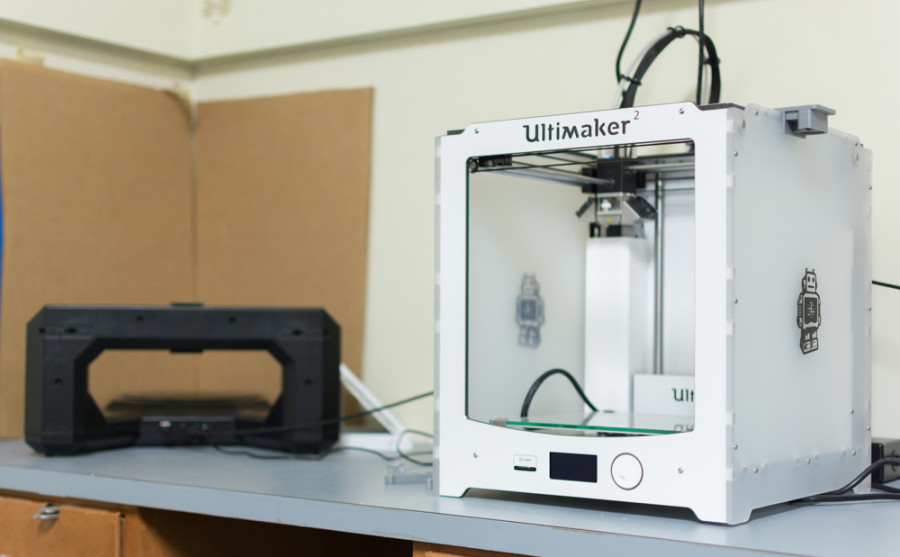Campus upgrades technology with 3D printers
November 4, 2015
In the new print lab in the Art building sit two small, white, futuristic looking cubes: two pieces of technology that are Cal State East Bay’s first glimpse into the future of printing.
“They’ve been kind of a carefully guarded secret,” said James Saxton, the lab coordinator who is in charge of maintaining the two school’s new Ultimaker three-dimensional printers, along with Robert Foster. Saxton and Foster are a part of the Multimedia Graduate Program and have extensive experience using and fixing 3D printers.
A 3D printer is like a hot glue gun mixed with a robot
This quarter is the first time that the CSUEB campus print lab has been open to the public, which has generated a lot of interest among the campus, according to Saxton. Students and faculty around the school have been making their way over to the Art Building in hopes of seeing the computer-controlled printers, which are capable of manufacturing multiple layers of material to produce three-dimensional objects of nearly any shape.
“The Multimedia Graduate Program has always paid a lot of attention to new technology that comes out,” Saxton said when asked about the main reason why the 3D printers were first sought. “A big part of it is exploring novel interaction between humans and computers.”
Renovated over the summer, the print lab space is the new “maker space” for art students and also features multiple types of ink printers and a new embroidery machine. The room had formerly functioned as the dark room in the Art Building since 1995. That is where Saxton once mixed chemicals and instructed people on how to use equipment 12 years ago, when he first started working at CSUEB.
“A 3D printer is like a hot glue gun mixed with a robot,” Saxton said. “You feed a tube of plastic in the back of a heated extruder nozzle, and it makes material. You layer it on top of each other and after it cools, it begins to harden.”
The time it takes to print depends on the type of resolution. Saxton explained that a low-resolution print can take 10 minutes and something with a higher resolution could take up to 10 hours.
First invented in 1984, 3D printers now use a wide range of materials including plastics, resins, metals and ceramics. Plastic is by far the most popular material and is currently used in the school’s lab. PLA and ABS are the main types of plastic filament that are used, although they can lead to technical issues such as clogging.
“We’re trying to expand who gets to use them and test it with a small group of people,” Saxton said. “We can’t open it up to everyone because right now, with the maintenance on these things, we have to make sure it’s sustainable and available to the people who paid for it.”
Right now, the 3D printers are available to the students in the Multimedia Graduate Program and soon will be available to a limited amount of students in the multimedia club on campus, Saxton explained.
The Multimedia Graduate Program has had 3D printers on campus in their own lab for about four years. The first was called the “U-Print” which cost upwards of $10,000. The two new Ultimaker printers in the print lab are worth roughly $2,000 each.
Students of the Multimedia Graduate Program began using the 3D printers for thesis projects, including “Project Daffodil,” which consisted of interactive electronic pop-up books and featured dragon figurines that were printed with the U-Print.
The goal of the project was to educate young people on various science principles as well as to get them into the STEM (Science, Technology, Engineering, and Math) initiative, all through the story of a young princess named Cassie and her pet dragon Sparkie. Created by graduate students Sian Geraghty, Robert Foster and Christine Ho, the project was featured at the 2015 Bay Area Maker Faire in San Mateo and won the Editor’s Choice Award.
3D printing technology has advanced quickly due to experimentation with new materials such as graphite, powder-based concrete and even glow-in-the-dark filaments.
“Irrespective of what the technology is, what is interesting is how it’s changing the way things are manufactured,” said Ian Pollock, assistant professor of Art and director of the Multimedia Graduate Program. “When it comes to industrial design, these printers are allowing individualization to take over mass production.”
















